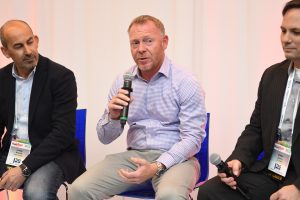2019 TranSPORT: Vendors Serve Up Their Take on the Current State of the Industry
Panelists represent the terrestrial, satellite, and IP sides of the business
Story Highlights
Over the past year, sports-video production has yet again experienced shifts in file transfer, content sharing, and other instances of transmission. Although leveraging in an at-home production model becomes a go-to option to save cash, more-complex broadcasts still rely on traditional methods for quality assurance.

The “State of TranSPORT: Vendor Perspectives” panel at 2019 TranSPORT: (from left) SVG’s Jason Dachman, Aldea Solutions’ Lionel Bentolila, CenturyLink’s Ryan Korte, and SES’s Bobby Stevens.
At the SVG TranSPORT conference, executives representing multiple forms of transmission analyzed the current state of the industry and hypothesized ways to enhance workflows for the sake of the ultimate product in the future.
CenturyLink Senior Director, Architecture, Ryan Korte on recent requests by his customers:
We’re seeing a lot of requests for remote productions, and I think that it’s really critical that we have first-mile bandwidth and dark fiber where we have it. [On 5G], I’m glad that we’re seeing so much [activity] around wireless connectivity, because most of those towers that do connect to fiber are actually used to get back to the network. The great news is that we’re probably coupling both of them together to make a stronger network.
First-mile bandwidth is really important because customers in other industries are starting to utilize the cloud. We’re partnering with the big cloud providers as well as our own compute platform where, instead of going 50 ms across to a cloud datacenter, we’re going to put the cloud 1 ms away or less from the remote edge.
Aldea Solutions CEO Lionel Bentolila and SES Sales Director, Sports and Events, Bobby Stevens on where 4K fits into the transmission equation:
Bentolila: We’ve been doing 4K transmissions for large events with FIFA, so all of the recent World Cup matches in Russia. We have customers that have plans to go to 4K, and, in some cases, we thought it would be imminent, because, when you look at everything that’s in the workflow, transmission is relatively easy compared to production and distribution. It has either been “Let’s go right away” or “Let’s slow down a little bit.”
Stevens: The demand [for 4K] is definitely rising. I think it originally comes from getting the production cameras upgraded, getting all of the [necessary] equipment in there, and getting everyone ready. Most large events are being recorded in 4K for archive because they’re going to be playing it out and doing clips for 4K. The transport is there: on both the fiber side and the satellite side, we have all of the infrastructure setup. I think it came as a function of the setup from the production side because, now that they have end clients with 4K TVs, it’s about putting content on there.

CenturyLink’s Ryan Korte (center) comments on recent customer requests and the potential of 5G as Aldea Solutions’ Lionel Bentolila (left) and SES’s Bobby Stevens look on.
Stevens on adapting business models to serve more events in a cost-effective manner:
It’s about being right along the efficiency line: bringing in content, doing more with it, and being more efficient with your workflow in both production and transmission. There are a lot of people looking towards the public internet, and it’s as good as long as it’s going to be there. It’s not a dire need. Those are great workflows to test in and bring in new technologies.
Bentolila on how companies account for the onslaught of transmission feeds coming out of high-profile events:
The bandwidth just keeps increasing, and you’re bringing in more feeds. It just increases the value of the production. From the value of the market itself, we don’t necessarily see it because the types of bandwidth that we deal with today are amazing compared to five years ago. At the end of the day, there are two things: there is the remote production that brings in more feeds, and there is also [the question] “How do you feed all of the OTT [streams]?” since OTT requires even more feeds. I think we’re just starting to see the beginning of it because it’s going to get much bigger.
All three panelists on the potential impact of 5G:
Korte: We believe that it’s going to provide a quickness and the ability to stand something quickly, get 5G capacity, and drive it across. Our strategy is a bit different in this regard as well: if we keep seeing 5G pop up in a given location or building, we’re going to put fiber in. We want to follow that 5G path and keep that spectrum or that wireless space available to keep moving to the destination that we don’t know about.
Bentolila: If you look at the evolution of bonded cellular, I think it’s going to follow that path except that we’re going to get better quality. It’s going to be a game-changer, and the technology is just going to make it easier. But I think that you really need to put that into the environment of what’s going to happen to the broadcast and OTT industries. We’ll look at 5G from a transmission point of view and helping us with the first mile, but I think that’s only one view and you need to look at how it’s going to affect the entire industry.
Stevens: The decision’s not out on what is actually going to be happening with 5G, but I think that the technology is going to keep up with it and support what we can handle on that same RF spectrum. As far as 5G as a technology for broadcast, we’re definitely in the testing stages with the NBA and doing it in a venue. [In regard to coverage,] it took a while for 4G to get out there, so I think we’re still a couple years out from having 5G on a broadcast because, when you’re doing broadcast, it has to be reliable. When you go out to a site survey, you’re not sure whether that 5G antenna is there or not, so it’s still a variable.
